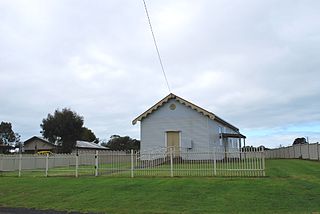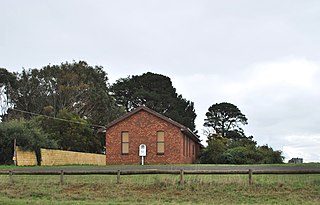Fission, a splitting of something into two or more parts, may refer to:
EL, El or el may refer to:

The Shire of Moyne is a local government area in the Barwon South West region of Victoria, Australia, located in the south-western part of the state. It covers an area of 5,481 square kilometres (2,116 sq mi) and in June 2018 had a population of 16,887. It includes the towns of Port Fairy, Koroit, Mortlake, Macarthur, Peterborough, Caramut, Ellerslie, Framlingham, Garvoc, Hawkesdale, Kirkstall, Panmure, Mailors Flat, Purnim, Wangoom and Woolsthorpe. It also entirely surrounds the City of Warrnambool, a separate local government area. It was formed in 1994 from the amalgamation of the Shire of Belfast, Shire of Minhamite, Borough of Port Fairy, and parts of the Shire of Mortlake, Shire of Warrnambool, Shire of Dundas, Shire of Mount Rouse and Shire of Hampden.

Peterborough is a town on the Great Ocean Road in Victoria, Australia, approximately three hours' drive from Melbourne. The town is situated on land to the west side of the mouth of the Curdies River.

Black Box is an abstract board game for one or two players, which simulates shooting rays into a black box to deduce the locations of "atoms" hidden inside. It was created by Eric Solomon. The board game was published by Waddingtons from the mid-1970s and by Parker Brothers in the late 1970s. The game can also be played with pen and paper, and there are numerous computer implementations for many different platforms, including one which can be run from the Emacs text editor.
Gosling or Goslings may refer to:
Slime or slimy may refer to:
Apel or APEL may refer to:
In organometallic chemistry, extended metal atom chains (EMACs) are molecules that consist of a linear chain of directly bonded metal atoms, surrounded by organic ligands. These compounds represent the smallest molecular wires. Such species are researched for the bottom-up approach to nanoelectronics, although no applications are near term.
Purnim is a small town in Victoria, Australia. The town is located 250 kilometres (155 mi) south west of the state capital, Melbourne, on the Hopkins Highway midway between Warrnambool and Mortlake. At the 2006 census, Purnim and the surrounding area had a population of 459.
Tees Maar Khan may refer to:

Cudgee is a locality in south west Victoria, Australia. The locality is in the Shire of Moyne, 241 kilometres (150 mi) west of the state capital, Melbourne.

Mepunga is a locality in south west Victoria, Australia. The locality is in the Shire of Moyne, 243 kilometres (151 mi) west of the state capital, Melbourne.

Rosebrook is a locality in southwest Victoria, Australia. The locality is in the Shire of Moyne, 282 kilometres (175 mi) west of the state capital, Melbourne.
Maar is a common type of volcanic crater.
The Eastern Maar people are a group of Aboriginal Australian peoples whose traditional lands are in the south-western part of state of Victoria, Australia. It is a name adopted by a number of Aboriginal Victorian groups who identify as Maar, including Eastern Gunditjmara, Tjap Wurrung, Peek Whurrong, Kirrae Whurrung, Kuurn Kopan Noot and/or Yarro waetch people. The word "Maar" means "the people".
This page is based on this
Wikipedia article Text is available under the
CC BY-SA 4.0 license; additional terms may apply.
Images, videos and audio are available under their respective licenses.





